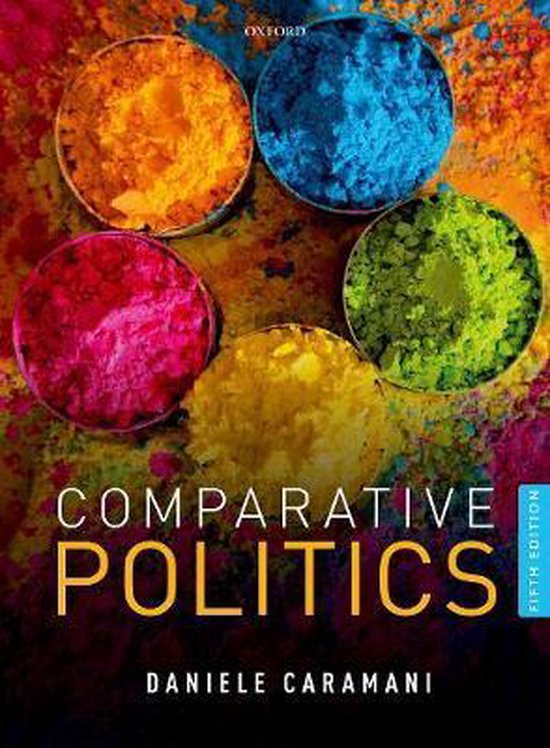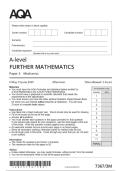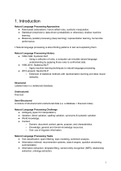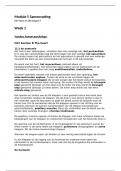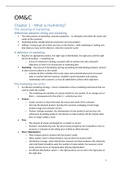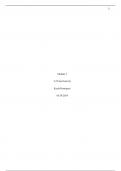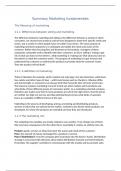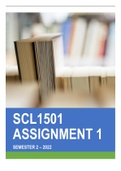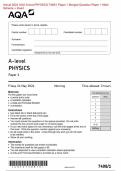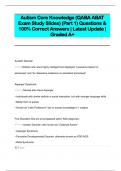Reading questions
WEEK 1. Introduction (introduction, ch1) _______________________________________________ 2
WEEK 2. Varieties of democracies (Clark, ch5, ch8) ________________________________________ 5
WEEK 3. Electoral systems (ch10, ch13) _______________________________________________ 10
WEEK 4. Parties and party systems (ch12, ch13, Pellikaan) _________________________________ 15
WEEK 5. Political participation and the public sphere (ch14, ch18, ch19) ______________________ 20
WEEK 6. The nation-state and supra-national constraints (ch4, ch24, Rodrik) __________________ 23
WEEK 7. The EU as a new political system (ch23, Lelieveldt)________________________________ 27
Practice questions exam ___________________________________________________________ 31
,WEEK 1. Introduction (introduction, ch1)
1. As a starting point of this course, write down how would you describe the field of comparative
politics in your own terms.
In the bottom, it is about studying politics by comparing two or more countries/phenomena/political
systems.
It is about looking at differences and similarities in structures, actors and processes (the system from
input to output), and learning from the output, using comparative methods (there are different
research methods, depending on what you want to explore).
- What: Comparing different area’s in politics, e.g. systems (structures, actors, processes, etc)
- How: Using methods of empirical analysis
- Why: To predict, explain, etc.
2. In the introductory chapter, Caramani states that comparative politics is one of the three main
subfields of political science, alongside international relations and political theory. He thereby
considers public administration as part of comparative politics. In some countries, by contrast, such as
the Netherlands, the United States and South Korea, political science and public administration are
rather seen as separate disciplines.
a. How would you define these disciplines (political science and public administration)?
Political science =
- Focus on input side; 1) Who makes decisions? 2) How do they get there? WHY do certain
things happen? 3) It focusses on political institutions.
- Focus on the external influences (of e.g. actors) on the government.
- So it is a much broader science than public administration.
- Social science where you study political structures, actors and systems
Public administration =
- Focus on output side; How is policy created? HOW do things happen? It also focusses on the
institutions (more specific than political science).
- Focus on government and related institutions (how it works, the process of decision making,
implementation of policy, etc.)
- More practical to prepare you for work in the sector.
b. And how do you think they are related to one another?
Political science is much broader than public administration. Public administration is in that sense only
a small part of political science (see question 2a).
The distinction between the three disciplines is not so neat. Because of globalization and increasing
interdependence and diffusion processes, the comparative politics and international relations are
going to one single discipline.
3. In the introductory chapter, Caramani discusses David Easton’s concept of political system.
a. What does this concept refer to?
A political system structures the way in which citizens preferences (input) are translated in policy
(output). P8-9
, - Input: The demands of the people. We know the demands by election results,
demonstrations, etc.
- System: The discussion in parliament, the way of decision making.
- Output: The policy
Chain of responsiveness: Links the citizens’ preferences (demands/support) to the decisions of policy
makers and thus to the results of policy making.
Feedback loop / chain of accountability: When decisions are made, the decision makers have to
account for their decisions. The government account for what they decide and how in parliament
(debates). This is by parliament (aftreden), demonstrations, voting, etc.
b. How can this concept help to get a better understanding of the relationship between political
science and public administration?
Political sciences can be shown in figures and a adjustment in public administration will cause an
adaption in the models. The models will give better insight in the way government is organized.
4. In which ways could comparative politics advice politicians?
In theory it could provide a lot information to change the political systems …
- From comparative politics, politicians can learn for example what state structure would be the
best (e.g. degree of democratization, what types of institutions, etc.) or what policy leads to
the most human well-being, the best quality and stability of government or to the highest
degree of satisfaction of the general public.
- Comparative politicians are consultants and advice governments on positive and negative
sides of systems.
… But in practice this is very hard to accomplish.
- E.G. In Spain there is a government with one or 2 parties. There was no majority for 1 party
and they didn’t know how to deal with a coalition government. Dutch political scientist came
to Spain to advice on how this works. The political system and culture (what you are used to)
is very difficult to change. (> Lijphart: Types of democracies; majority decides versus
consensus and collaboration)
5. In which ways could comparative politics advice the general public?
They act as public intellectuals to inform the general public. It leads to an understanding of the way
different political institutions influence each other. This gives insights in how some things lead to
certain outcomes.
E.G. In the tobacco industry, there was an advisory group. 9 out of 10 members were however
member of an interest group. The group had to advise the Dutch government about two systems (of
which one failed). All groups tried to influence the government.
You have to be critical on who is in the group, what the interests are, etc. There are always interest
conflicts because people differ, that is essentially politics. The government isn’t neutral either.
6. The second chapter discusses the ‘institutional turn’ in the social sciences.
a. What does this turn refer to?
, A shift away from focus on structural variables for explaining why some societies are more successful
than others in providing human well-being.
- Structural factors: Lead directly to output. For example, if you want to say something about
life expectation, you may look at the amount of money in your country.
- Political institutions: For example Africa; if we donate 20mln, but 10mln goes to the output
and the rest is lost in the political institutions by corruption.
Also: the institutional system can change the structural factors.
So this turn refers to the discovery societies/countries become successful if their institutions function
well. A focus to the quality of government institutions (e.g. no corrupt government).
Government effectiveness is more important than democracy for the level of human development.
b. How is the institutional turn related to the idea that comparative politics has a potential for serving
more general goals, like increased social justice and improved human well-being?
Do not focus too much on democracy. Focus on efficiency and effectiveness (quality of governance). >
Advise about what makes governmental, judicial and administrative institutions of good quality.
WEEK 1. Introduction (introduction, ch1) _______________________________________________ 2
WEEK 2. Varieties of democracies (Clark, ch5, ch8) ________________________________________ 5
WEEK 3. Electoral systems (ch10, ch13) _______________________________________________ 10
WEEK 4. Parties and party systems (ch12, ch13, Pellikaan) _________________________________ 15
WEEK 5. Political participation and the public sphere (ch14, ch18, ch19) ______________________ 20
WEEK 6. The nation-state and supra-national constraints (ch4, ch24, Rodrik) __________________ 23
WEEK 7. The EU as a new political system (ch23, Lelieveldt)________________________________ 27
Practice questions exam ___________________________________________________________ 31
,WEEK 1. Introduction (introduction, ch1)
1. As a starting point of this course, write down how would you describe the field of comparative
politics in your own terms.
In the bottom, it is about studying politics by comparing two or more countries/phenomena/political
systems.
It is about looking at differences and similarities in structures, actors and processes (the system from
input to output), and learning from the output, using comparative methods (there are different
research methods, depending on what you want to explore).
- What: Comparing different area’s in politics, e.g. systems (structures, actors, processes, etc)
- How: Using methods of empirical analysis
- Why: To predict, explain, etc.
2. In the introductory chapter, Caramani states that comparative politics is one of the three main
subfields of political science, alongside international relations and political theory. He thereby
considers public administration as part of comparative politics. In some countries, by contrast, such as
the Netherlands, the United States and South Korea, political science and public administration are
rather seen as separate disciplines.
a. How would you define these disciplines (political science and public administration)?
Political science =
- Focus on input side; 1) Who makes decisions? 2) How do they get there? WHY do certain
things happen? 3) It focusses on political institutions.
- Focus on the external influences (of e.g. actors) on the government.
- So it is a much broader science than public administration.
- Social science where you study political structures, actors and systems
Public administration =
- Focus on output side; How is policy created? HOW do things happen? It also focusses on the
institutions (more specific than political science).
- Focus on government and related institutions (how it works, the process of decision making,
implementation of policy, etc.)
- More practical to prepare you for work in the sector.
b. And how do you think they are related to one another?
Political science is much broader than public administration. Public administration is in that sense only
a small part of political science (see question 2a).
The distinction between the three disciplines is not so neat. Because of globalization and increasing
interdependence and diffusion processes, the comparative politics and international relations are
going to one single discipline.
3. In the introductory chapter, Caramani discusses David Easton’s concept of political system.
a. What does this concept refer to?
A political system structures the way in which citizens preferences (input) are translated in policy
(output). P8-9
, - Input: The demands of the people. We know the demands by election results,
demonstrations, etc.
- System: The discussion in parliament, the way of decision making.
- Output: The policy
Chain of responsiveness: Links the citizens’ preferences (demands/support) to the decisions of policy
makers and thus to the results of policy making.
Feedback loop / chain of accountability: When decisions are made, the decision makers have to
account for their decisions. The government account for what they decide and how in parliament
(debates). This is by parliament (aftreden), demonstrations, voting, etc.
b. How can this concept help to get a better understanding of the relationship between political
science and public administration?
Political sciences can be shown in figures and a adjustment in public administration will cause an
adaption in the models. The models will give better insight in the way government is organized.
4. In which ways could comparative politics advice politicians?
In theory it could provide a lot information to change the political systems …
- From comparative politics, politicians can learn for example what state structure would be the
best (e.g. degree of democratization, what types of institutions, etc.) or what policy leads to
the most human well-being, the best quality and stability of government or to the highest
degree of satisfaction of the general public.
- Comparative politicians are consultants and advice governments on positive and negative
sides of systems.
… But in practice this is very hard to accomplish.
- E.G. In Spain there is a government with one or 2 parties. There was no majority for 1 party
and they didn’t know how to deal with a coalition government. Dutch political scientist came
to Spain to advice on how this works. The political system and culture (what you are used to)
is very difficult to change. (> Lijphart: Types of democracies; majority decides versus
consensus and collaboration)
5. In which ways could comparative politics advice the general public?
They act as public intellectuals to inform the general public. It leads to an understanding of the way
different political institutions influence each other. This gives insights in how some things lead to
certain outcomes.
E.G. In the tobacco industry, there was an advisory group. 9 out of 10 members were however
member of an interest group. The group had to advise the Dutch government about two systems (of
which one failed). All groups tried to influence the government.
You have to be critical on who is in the group, what the interests are, etc. There are always interest
conflicts because people differ, that is essentially politics. The government isn’t neutral either.
6. The second chapter discusses the ‘institutional turn’ in the social sciences.
a. What does this turn refer to?
, A shift away from focus on structural variables for explaining why some societies are more successful
than others in providing human well-being.
- Structural factors: Lead directly to output. For example, if you want to say something about
life expectation, you may look at the amount of money in your country.
- Political institutions: For example Africa; if we donate 20mln, but 10mln goes to the output
and the rest is lost in the political institutions by corruption.
Also: the institutional system can change the structural factors.
So this turn refers to the discovery societies/countries become successful if their institutions function
well. A focus to the quality of government institutions (e.g. no corrupt government).
Government effectiveness is more important than democracy for the level of human development.
b. How is the institutional turn related to the idea that comparative politics has a potential for serving
more general goals, like increased social justice and improved human well-being?
Do not focus too much on democracy. Focus on efficiency and effectiveness (quality of governance). >
Advise about what makes governmental, judicial and administrative institutions of good quality.

